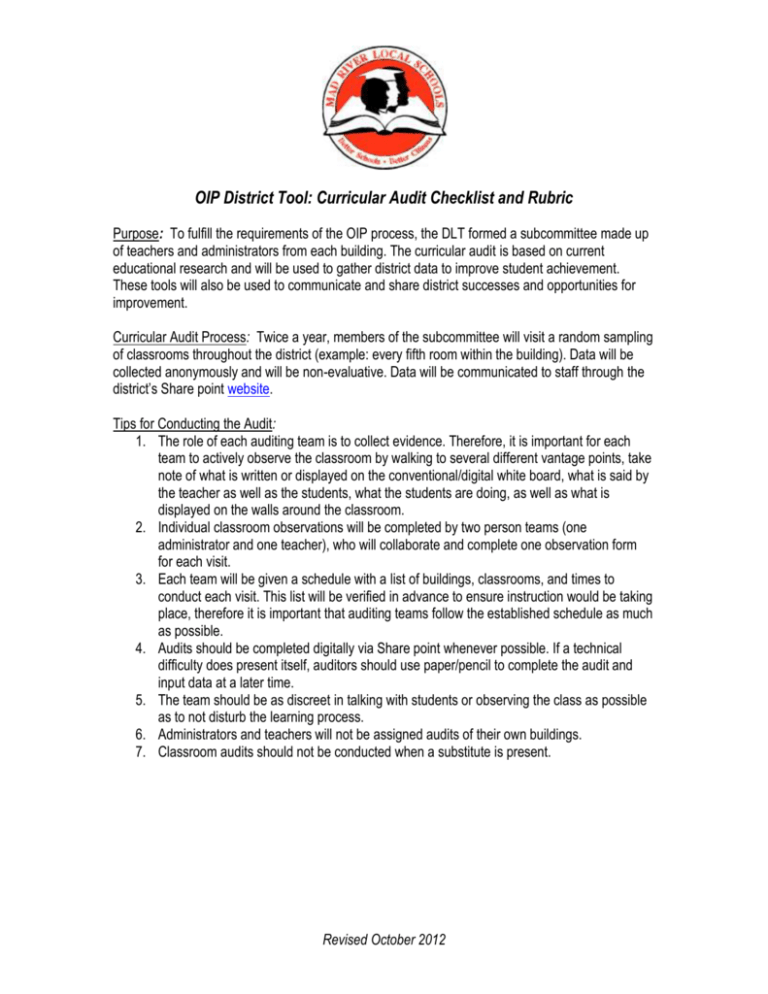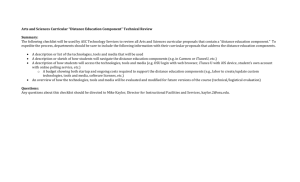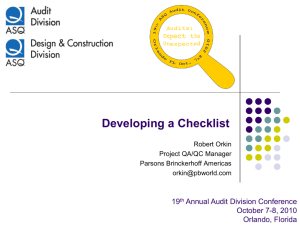Teacher Self Reflection and District Curricular Audit
advertisement

OIP District Tool: Curricular Audit Checklist and Rubric Purpose: To fulfill the requirements of the OIP process, the DLT formed a subcommittee made up of teachers and administrators from each building. The curricular audit is based on current educational research and will be used to gather district data to improve student achievement. These tools will also be used to communicate and share district successes and opportunities for improvement. Curricular Audit Process: Twice a year, members of the subcommittee will visit a random sampling of classrooms throughout the district (example: every fifth room within the building). Data will be collected anonymously and will be non-evaluative. Data will be communicated to staff through the district’s Share point website. Tips for Conducting the Audit: 1. The role of each auditing team is to collect evidence. Therefore, it is important for each team to actively observe the classroom by walking to several different vantage points, take note of what is written or displayed on the conventional/digital white board, what is said by the teacher as well as the students, what the students are doing, as well as what is displayed on the walls around the classroom. 2. Individual classroom observations will be completed by two person teams (one administrator and one teacher), who will collaborate and complete one observation form for each visit. 3. Each team will be given a schedule with a list of buildings, classrooms, and times to conduct each visit. This list will be verified in advance to ensure instruction would be taking place, therefore it is important that auditing teams follow the established schedule as much as possible. 4. Audits should be completed digitally via Share point whenever possible. If a technical difficulty does present itself, auditors should use paper/pencil to complete the audit and input data at a later time. 5. The team should be as discreet in talking with students or observing the class as possible as to not disturb the learning process. 6. Administrators and teachers will not be assigned audits of their own buildings. 7. Classroom audits should not be conducted when a substitute is present. Revised October 2012 OIP District Tool: Curricular Audit Checklist and Rubric Observation Date: Approximate number of students on task: all/most about ¾ about ½ about ¼ few/none Observation Time: Observer Group #: School: Dominant Student Activity: (Check all that apply) Whole group work. Cooperative group work. Individual work. Using technology Taking assessment. Flexible grouping or intervention Other: _______________ Bloom’s Revised Taxonomy: (Check all that apply) Remember: Can the student recall or remember the information? Define, duplicate, list, memorize, recall, repeat, reproduce state Understand: Can the student explain ideas or concepts? Classify, describe, discuss, explain, identify, locate, recognize, report, select, translate, paraphrase Apply: Can the student use the information in a new way? Choose, demonstrate, dramatize, employ, illustrate, interpret, operate, schedule, sketch, solve, use, write. Analyze: Can the student distinguish between the different parts? Appraise, compare, contrast, criticize, differentiate, discriminate, distinguish, examine, experiment, question, test. Evaluate: Can the student justify a stand or decision? Appraise, argue, defend, judge, select, support, value, evaluate Create: Can the student create new product or point of view? Assemble, construct, create, design, develop, formulate, write. http://ww2.odu.edu/educ/roverbau/Bloom/blooms_taxonomy.htm Revised October 2012 OIP District Tool: Curricular Audit Checklist and Rubric 1.2/2.2/3.1 The district will ensure the implementation of research-based instructional strategies. Formative Instructional Practices: (Check all that apply) Establish clear learning targets for students. A standards-based learning target is highly visible in the classroom. A standards-based learning target is expressed in student-friendly language. Students can clearly articulate the expectations of the lesson (Students can answer all the following prompts successfully): What is your learning target? (FIP = Where are you going?) Why do you need to know this information? (CCR) How are you doing with that learning target? (FIP =Where are you now?) What do you need to do to be successful? (FIP = Are you on the right path?) Collect and document accurate evidence of student learning. Evidence that student academic, performance data is collected. Provide effective feedback Evidence that teachers provide effective feedback. (verbal and/or written) Prepare students to engage in self-assessment, peer feedback, and goal setting. Rubrics, checklists, or other documents are used to clearly establish the guidelines for assignments. Examples of proficient and exemplary student work are displayed throughout the classroom. Examples of individual, classroom and/or grade-level goals are posted. Students are actively participating in self-assessment and/or providing peer feedback. 2.2 Implement research-based instructional strategies for mathematics in all content areas. Common Core Research-Based Math Strategies (Standards for Mathematical Practices): Make sense of problems and preserve in solving them. Reason abstractly and quantitatively. Construct viable arguments and critique the reasoning of others. Model with mathematics. Use appropriate tools strategically. Attend to precision. Look for and make use of structure. Look for an express regularity in repeated reasoning. http://www.corestandards.org/Math Revised October 2012 OIP District Tool: Curricular Audit Checklist and Rubric District Math Focus Area: Number Sense Research-Based Math Strategies: Model and/or discuss different strategies for computing. Ask students to calculate mentally. Use estimation as part of computing. Question students about how they reason numerically. Pose numerical problems that have more than one possible answer. www.mathsolutions.com/documents/.../10_CMC_MF_NumberSense Math strategies not observed. 1.2 Implement research-based instructional strategies for reading in all content areas. Common Core Research-Based Reading Strategies Key Ideas and Details Craft and Structure Integration of Knowledge and Ideas Range of Reading and Level of Text Complexity http://www.corestandards.org/ELA-Literacy/RI District Reading Focus Area: Informational Text Strategies: Academic Summary Investigative Reading Marking a Text Prereading Literature Circle; Book Club; Socratic Seminar Writing in the Margins Organizing Information Charting a Text Integrating Sources www.literacyta.com/common-core-standards/reading Reading strategies not observed. Revised October 2012 OIP District Tool: Curricular Audit Checklist and Rubric 1.1/2.1. The district will implement a consistent, rigorous PK-12 curriculum based on the Common Core State Standards. 21st Century Skills needed for College and Career Readiness The teacher provides opportunities for students to engage in or develop the following 21st Century Skills (check all that are observed): Learning and Innovation Skills: Critical thinking and problem solving Communications and collaboration Creativity and innovation Information, Media, and Technology Skills (Digital Literacy): Information literacy Media literacy Information and communication technologies (ICT) literacy Career and Life Skills Flexibility and adaptability Initiative and self-direction Social and cross-cultural interaction Productivity and accountability Leadership and responsibility Partnership for 21st Century Skills: http://www.p21.org 3.2. The district will ensure the implementation of a system of positive behavioral support which includes all students and sub groups. Active supervision is used to maintain appropriate behaviors consistently and fairly. Actively engages with class. Scanning for problems or early warning signs of trouble. Frequent positive contacts are given. Individuals or groups are acknowledged for following the rules. Behavior is corrected calmly and firmly. Redirection to expected behaviors is used. Classroom behavior system is visible. Class attention-getting signals are used effectively. Revised October 2012





